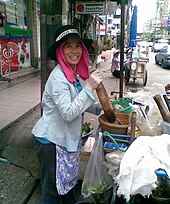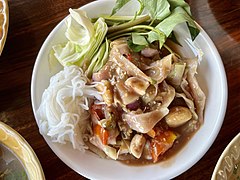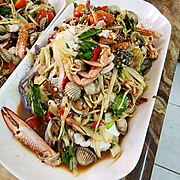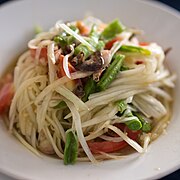Green papaya salad (Burmese: သင်္ဘောသီးသုပ်, Khmer: បុកល្ហុង, Lao: ຕຳຫມາກຫຸ່ງ/ຕໍາສົ້ມ, Rakhine: ပဒကာသီးသုပ်, Thai: ส้มตำ, Northeastern Thai: ตำบักหุ่ง/ตำส้ม, and Vietnamese: gỏi đu đủ) is a spicy salad made from shredded unripe papaya. It is generally believed to have been created by the Lao people[1][2][3][4] and is considered one of the national dishes of Laos.[5][6][7] Green papaya salad is also popular in neighbouring Thailand's Isan region, whose population is mainly composed of ethnic Lao and from where it spread to the rest of Thailand.[8][9][10][11][12][13] Green papaya salad has also spread to the rest of the continental Southeast Asia (Cambodia, Myanmar,[14] and Vietnam[15]), as well as Xishuangbanna (China).
 | |
| Type | Salad |
|---|---|
| Place of origin | Laos |
| Region or state | Laos |
| Associated cuisine | Xishuangbanna (China), Burmese, Cambodian, Lao, Thai, Vietnamese |
| Main ingredients | Green papaya |
History
Papayas and chili peppers were introduced to Southeast Asia by the Spanish and Portuguese explorers in the 17th century from the Americas.[16] Simon de la Loubère (1642-1729), a French diplomat, mentioned in his book that the cultivation of papaya was already widespread in Siam in 1693.[17][18]Although it is unknown when papayas and chili peppers entered Laos specifically, they had already been fully integrated into the Lao territory by the time Jean-Baptiste Pallegoix and Henri Mouhot visited in mid-1800s,[19][20] and were listed among key ingredients for preparing main Lao dishes.[21][22][23] Tam som was mentioned as a favorite Lao dish by a former Lao politician, Katay Don Sasorith (1904-1959), in a memoir recounting his experience during his primary school years in 1910s.[24] Papaya, among other fruits, were cultivated in Cambodia by Chinese settlers who immigrated in the 1500s from Hainan, China.[25] The Lao name for papaya is mak hung and was likely derived from l'hun or lohung/rohung as papayas are called in Khmer through Khmer Loeu living in provinces bordering the southeastern Laos.[26]
Thai historian Sujit Wongthes has speculated that the green papaya salad originated in the communities of ethnic Chinese–Lao settlers living in what is now Central Thailand, who adopted the ancient Lao tradition of preparing salads from fruits, called tam som, to make salads from papayas. The new dish became known as som tam (the reversed order of tam som) during the early Rattanakosin period in late 18th to early 19th centuries and, along with the papayas, then spread to today's Northeast Thailand following the construction of the Northeastern railway line during the turn of the 19th–20th centuries. The dish became more popular after the opening of Mittraphap Road in 1957, and has since become widely adopted by the ethnic Lao people of both Isan and Laos. Likewise, the hot flavour also spread to Isan and Laos from Central Thailand, which had been introduced to chilli peppers first.[27]
However, papayas and chili peppers were already integrated in the Lao territory and Lao culinary recipes in mid-1800s to early 1900s[19][20][21][24] while, during the 1950s and 1960s, green papaya salad and other Lao dishes were rarely known in Bangkok. They could only be found around the boxing stadium that gathered boxers and fans from Northeastern Thailand, as well as in mobile food carts outside construction sites with Northeastern workers and gas stations serving long-distance bus drivers. Some believe that som tam gained popularity among the young Thai generations following an active publicity in the 1970s.[28][29] Furthermore, it was created using refined recipes of Lao tam som, or tam mak hung,[30][31][32] likely brought to Bangkok by migrant workers from the Northeast during the mid-1900s.[33] During the standardization of the Thai national cuisine, green papaya salad was among the Northeastern or Lao dishes to be included into the Thai national cuisine and modified by reducing the amount of chilli peppers and increasing the amount of sugar.[34]
Others believe that som tam has evolved from a Thai dish called pu tam (Thai: ปูตำ, lit. 'Crab Salad') mentioned in a recipe by chef Plien Passakornwong in her 1908 cookbook. This dish shares similarities with modern-day som tam but does not include papaya as an ingredient.[35][33] The earliest known recipe of som tam in Thailand appeared in the Yaowapha cookbook series by Phra Chao Boromawong in 1935, which included Som tam ton malakor (Thai: ส้มตำต้นมะละกอ) or Khao man som tam (Thai: ข้าวมันส้มตำ). This recipe is similar to som tam as prepared today and includes roasted peanuts and dried shrimp as key ingredients. It is often served with rice cooked in coconut milk.[36][35][33][37]
Preparation

The dish combines the five main basic tastes: the sourness of the lime, spiciness of the chili, saltiness and savoriness of the fish sauce, and sweetness of palm sugar.[disputed ] The ingredients are mixed and pounded in a mortar, which is reflected in the Khmer, Lao and Thai names for the dish that literally mean "pounded papaya".
In Laos, green papaya salad is one of the traditional staples of the Lao. Pounded salads in Laos all fall under the parent category of tam som, which may or may not contain green papaya, however, when no specific type of tam som is mentioned, it is generally understood to refer to green papaya salad. For absolute clarity, however, the name tam maak hoong may be used, since this name means "pounded papaya".
In Thailand, it is customary that a customer ask the preparer to make the dish suited to his or her tastes. To specifically refer to the original style of papaya salad as prepared in Laos or Isan, it is known as ส้มตำลาว or som tam Lao or simply as tam Lao and the dish as prepared in central Thailand may be referred to as som tam Thai.
Traditionally, the local variety of green papaya salad in the streets of Bangkok is very spicy due to the addition of a fistful of chopped hot bird's eye chili. However, with its rising popularity among tourists, it is now often served less spicy as it used to be in the past.
Additional ingredients


Together with the papaya, some or most of the following secondary items are added and pounded in the mortar with the pestle:
- Asparagus beans
- Brined "rice field crabs". These belong to the freshwater crab genera Sayamia, Chulathelphusa, and Esanthelphusa (previously classified as part of the genus Somanniathelphusa), which all belong to the Gecarcinucid crab subfamily Parathelphusinae.[38] found in flooded rice fields and canals. Isan people eat the entire crab, including the shell.
- Chili pepper
- Dried shrimp
- Fish sauce
- Garlic
- Monosodium glutamate
- Hog plums
- Lime slice and lime juice
- Palm sugar
- Shrimp paste
- Fish paste
- Raw Thai eggplant
- Cherry or grape tomatoes (green or ripe)
Green papaya salad is often served with glutinous rice and kai yang/ping gai (grilled chicken). It can also be eaten with fresh rice noodles or simply as a snack by itself with, for instance, crispy pork rinds. The dish is often accompanied by raw green vegetables such as water spinach and white cabbage wedges on the side to mitigate the spiciness of the dish.
Variations
It is believed to have originated in Laos, from where it was exported into Cambodia, Thailand and Vietnam.[39][3][4][better source needed] Variations of the dish are found throughout Thailand, Cambodia,[40] Vietnam and as well as in the West, where it is more commonly known by its Thai name.[citation needed]
A non-spicy green papaya salad version also exists in Laos, Vietnam and Thailand, which is much sweeter; it often contains crushed peanuts and is less likely to have fish paste or brined crab.[41] Dried brine shrimp are used in this Central Thai version. There are also versions that make use of unripe mangoes, apples, cucumbers, carrots and other firm vegetables or unripe fruit. Besides using varieties of fruits or vegetables as the main ingredient a popular option is to use vermicelli rice noodles wherein the dish is known as tam sua.[42]
Instead of papaya, other ingredients can be used as the main ingredient. Popular variations in Laos and Thailand include the salad with:[citation needed]
- Cucumber, usually the small variety (tam maak taeng, tam taengkwa)
- Green and unripe mango (tam maak muang, tam mamuang)
- Green and unripe bananas (tam maak kuai, tam kluai)
- Hard and unripe santol (tam krathon)
- Banana flowers (tam hua pli)
- Malay gooseberry (tam mayom)
- Pomelo (tam som o)
- Mu yo sausage (tam mu yo)
- Mixed fruit (tam phonlamai ruam)
- Coconut rice (khao man som tam)
Reception
The Thai variation som tam has been listed at number 46 on World's 50 most delicious foods[43] compiled by CNN Go in 2011[44] and 2018.[45]
Gallery
- Lao papaya salad with pork rinds
- Luang Prabang style Lao papaya salad from Northern Laos
- Lao papaya salad with selected crustacea, mollusks, and shellfish in addition to papaya strips
- Thai green papaya salad with peanuts
- Green papaya salad with brined rice paddy crabs (som tam pu)
- Green papaya salad with mixed fruit (tam phonlamai ruam)
- Green papaya salad with banana flowers (tam hua pli)
- Green papaya salad with mu yo sausage (tam mu yo)
- A variation of the salad with green mango instead of papaya and dried anchovies (tam mamuang pla haeng thot)
- Tam maphrao on sen mi krop: a variation with soft coconut meat and deep-fried rice noodle
See also
References
Further reading
- Cummings, Joe. (2000). World Food: Thailand. UK: Lonely Planet Publishers. pp. 157–8. ISBN 1-86450-026-3
- Williams, China ‘’et al.’’. (). ‘’Southeast Asia on a Shoestring: Big Trips on Small Budgets.’’ Lonely Planet. p. 31. ISBN 1-74104-164-3
- Brissenden, Rosemary. (2007). Southeast Asian food: Classic and Modern Dishes from Indonesia, Malaysia, .. Tuttle Publishing. pp. 434 – 439. ISBN 0-7946-0488-9
- McDermoot, Nancie. (1992). Real Thai: The Best of Thailand’s Regional Cooking. Chronicle Books. pp. 121 – 146. ISBN 0-8118-0017-2











